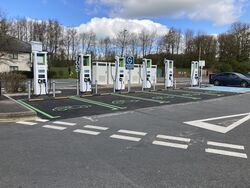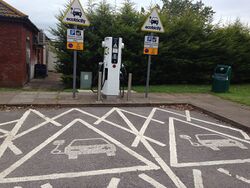Electric Vehicles
The overwhelming majority of service areas have fitted electric vehicle charging points.
On the UK motorway network, the vast majority are provided under the Electric Highway name, which until recently was owned by Ecotricity. Most of these charging points were first installed in 2007, and while they may have been refurbished since, there had been a lot of comments that they were not reliable or able to provide the service needed.
The Electric Highway is now owned by GRIDSERVE, who pioneered the electric forecourt, and they are promising to invest in it. Moto have said they want a minimum of six high-powered chargers across half of their estate by the end of the year, ahead of the government's own target, with Moto's theory being that by 2030, 30% of their customers will be using electric vehicles.
The big forecourt operators have been rolling out charging points under their own name, and this includes Applegreen, who are able to roll out rapid charging points at their Welcome Break motorway service areas. This could shake up the choice of motorway charging units, with Tesla Supercharger and IONITY also being introduced at some sites.
Issues with a charging point should be sent to the charging point brand, who usually manage it on behalf of the operator. Note that while we try to stay up-to-date with regards to new installations and faults, we can only rely on the information we're given. Complaints about ICE vehicles obstructing charging areas should be sent to the operator.
Motorway Charging Point Locator
You can use our search engine to detail all the charging points at official service areas on any selected road, or search by other criteria. This form will direct to the UK section.
Charging Point Brands
The names above outline the key players on the major road network, there are a number of different charging points provided at service areas. These include:
- Alfa Power
- Applegreen
- BP Pulse (previously BP Chargemaster)
- ChargePlace Scotland
- ecarNI
- Electric Highway (previously Ecotricity)
- ESB ecars
- GeniePoint
- GRIDSERVE
- InstaVolt
- IONITY
- LiFe EV is operated by RAW Charging
- MFG EV Power
- Pod Point
- Shell Recharge
- Tesla Supercharger
This is not an exhaustive list of EV charging brands, only those at official service areas. This website is not in a position to advise on the merits of different charging brands.
Charging Point History


The UK service area regulations contained no reference to charging points until 2013, even though operators had been fitting them since before the previous regulations were written. Despite this, the 2013 update merely said that it encouraged operators to provide recharging facilities and alternative fuel technologies. This received fawning media coverage.
At the same time the regulations were updated to acknowledge that there is an official symbol for electric vehicle charging points, and to advise that this can be used on motorway signs to advertise the facility. In most cases, it is substituted for another food brand.
Providing an electric vehicle charging point finally became a mandatory obligation of motorway service areas in 2017. The announcement came with much government fanfare, even though just about every motorway service area already had one. In fact not only did most motorway service areas already have one, but Little Chef had already created a network of about 80 chargers which covered many major A-roads, and would go on to outlive their brand.
In March 2019, Highways England awarded BP Chargemaster and Swarco a £2.8million contract to install new charging points at public locations close to the major road network.
At the start of 2020, Roadchef, Welcome Break and BP were all quoted criticising the UK's electricity infrastructure, which they said was hindering their roll-out of charging facilities.
What was called "Britain's first electric forecourt" opened in December 2020. GRIDSERVE at Braintree is effectively a normal major road service area, but with various types of electric charger instead of fuel pumps. With GRIDSERVE planning more sites, this is likely to encourage operators to step up a gear, and indeed MFG soon started building their own equivalents. For example at Colne Valley, Welcome Break have already committed to building 100 charging points (brand not known), way above the dozen-or-so that they usually provide.
Roadchef started adding canopies (or, "wet weather protection") to their new charging areas in 2022, saying it was a common request from customers.
Government Intervention
In March 2021, Transport Minister Rachel Maclean told Electrifying.com that the British government would be spending nearly £1 billion on improving the electric vehicle chargers on main roads. She said every motorway service area would have at least six rapid chargers by 2023, and that there would be 6,000 chargers across the major road network by 2030. These would be available to all road users with a contactless payment card, and the companies provided them would be contractually bound to provide a service that works at least 99% of the time, and to provide a 24 hour customer support line.
Although it wasn't stated explicitly, most electric vehicle drivers have interpreted this as being an end to Ecotricity's dominance of the motorway network. The minister's comments also suggested that the government's policy of allowing the private sector to decide what's needed hadn't worked, and that they now believe they have to intervene.
While the government's enthusiasm is undoubtedly good news for electric vehicle drivers, there is always a pinch of salt required when dealing with government commitments. Some electric vehicle driver also suggested that six chargers may not be enough in 2023. Moto have said they are aiming to hit this target for most of their network before 2022.
Ecotricity formally sold their 'Electric Highway' network of motorway charging points to GRIDSERVE in June 2021. Ecotricity said the sale would allow GRIDSERVE to invest in the network, and to expand it in line with the government's expectations. GRIDSERVE had already been upgraded many of Ecotricity's chargers, and were now looking to refurbish the whole network. This process included working closely with Moto, who heralded the opening of their site at Rugby as being a landmark moment for electric vehicle charging.
The UK's Competition and Markets Authority announced in July 2021 that they would be investigating the exclusivity arrangement between the Electric Highway and Moto, Roadchef and Extra. They also advised that the government's charger upgrade funding should only be provided on condition that motorists are offered more choice. This resulted in GRIDSERVE announcing that they would no longer enforce their exclusivity arrangements after 2026, and that they wouldn't take action against any rival charger funded via the Rapid Charging Fund.
A further intervention was announced in November 2021, when National Highways announced they would be investing £11m in energy storage systems, which would reinforce the electricity supply at up to 20 service areas that are experiencing issues with their energy connection.
Charging Hubs

High-powered electric vehicle charging hubs (that are accessible to many vehicles) are now provided at the official motorway service areas at:
- Burton-in-Kendal (M6) (northbound only)
- Exeter (M5)
- Heston (M4) (westbound only)
- Leigh Delamere (M4) (westbound only)
- Pease Pottage (M23)
- Rugby (M6)
- Severn View (M48)
- Swansea West (M4)
- Thurrock (M25/A13/A282)
- Wetherby (A1(M))
- Woolley Edge (M1)
In December 2021 GRIDSERVE promised us a number of new motorway sites that would open in 2022. Many of these were already rumoured, while some were new.
The chosen list is so far all Moto locations, and appears to be partly down to the available space as much as it is about demand. There is also a curious preference for motorists who are travelling west.
Reading westbound will join the list soon.

